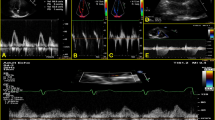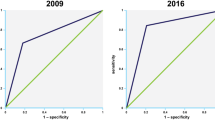Abstract
2016 guidelines for the echographic evaluation of left ventricular filling pressure (LVFP) proposed a single algorithm with limited number of criteria (E/A ratio, tricuspid regurgitation velocity, left atrial volume index and average E/e′) mainly related to left atrial pressure. Pulmonary venous flow analysis, evaluating more specifically left ventricular end diastolic pressure (LVEDP) has been withdrawn. We aim to evaluate the proportion of patients diagnosed with normal LVFP according to 2016 recommendations, despite an abnormal pulmonary venous flow profile suggesting high LVEDP. We prospectively studied patients with stable ischemic cardiomyopathy and aortic stenosis, before cardiac surgery. Extensive echocardiography was performed including pulmonary and mitral A wave durations. We included 76 patients (mean age 72 ± 10 years, 78% were men), 37 (49%) with aortic stenosis and 22 (29%) with ischemic cardiomyopathy. Mean left ventricular ejection fraction was 67 ± 11%. Applying recommendations, 58 patients had normal LVFP and 15 patients had high LVFP. Among the 58 patients with normal LVFP, 26 patients had Apd–Amd duration > 30 ms highly suggestive of high LVEDP. These patients had higher LV mass (112 ± 30 g/m2 vs. 86 ± 20 g/m2, p = 0.004) and shorter A wave duration (120 ± 13.6 ms vs. 132 ± 16.5 ms, p = 0.006) as compared to the remaining 15 patients with concordant evaluation (normal LVFP and normal Apd–Amd). In the present study, we found that 26/58 patients with low LVFP according to the 2016 recommendations had Apd–Amd suggestive of high LVEDP. Pulmonary venous flow should be added to the algorithm, particularly in patients with unexplained symptom, high LV mass or truncated mitral A wave.



Similar content being viewed by others
References
Nagueh SF, Appleton CP, Gillebert TC, Marino PN, Oh JK, Smiseth OA et al (2009) Recommendations for the evaluation of left ventricular diastolic function by echocardiography. J Am Soc Echocardiogr 22(2):107–133
Nagueh SF, Smiseth OA, Appleton CP, Byrd BF, Dokainish H, Edwardsen T et al (2016) Recommendations for the evaluation of left ventricular diastolic function by echocardiography: an update from the American Society of Echocardiography and the European Association of Cardiovascular Imaging. J Am Soc Echocardiogr 29(4):277–314
Braunwald E, Brockenbrough EC, Frahm CJ, Ross J (1961) Left atrial and left ventricular pressures in subjects without cardiovascular disease: observations in eighteen patients studied by transseptal left heart catheterization. Circulation 24:267–269
Braunwald E, Frahm CJ (1961) Studies on Starling’s Law of the heart: observations on the hemodynamic functions of the left atrium in man. J Clin Invest 40:633–642
Rahimtoola SH, Ehsani A, Sinno MZ, Loeb HS, Rosen KM, Gunnar RM (1975) Left atrial transport function in myocardial infarction. Importance of its booster pump function. Am J Med 59(5): 686–694.
Rahimtoola SH (1973) Left ventricular end-diastolic and filling pressures in assessment of ventricular function. Chest 63(6):858–860
Peverill R (2015) “Left Ventricular Filling Pressure(s)” ambiguous and misleading terminology, best abandoned. Int J Cardiol 191:110–113
Rossvoll O, Hatle LK (1993) Pulmonary venous flow velocities recorded by transthoracic Doppler ultrasound: relation to left ventricular diastolic pressures. J Am Coll Cardiol 21(7):1687–1696
Yamamoto K, Nishimura RA, Burnett JC, Redfield MM (1997) Assessment of left ventricular end-diastolic pressure by Doppler echocardiography: contribution of duration of pulmonary venous versus mitral flow velocity curves at atrial contraction. J Am Soc Echocardiogr 10(1):52–59
Cheitlin MD, Armstrong WF, Aurigemma GP, Beller GA, Bierman FZ, Davis JL et al (2003) ACC/AHA/ASE 2003 guideline update for the clinical application of echocardiography: a report of the American College of Cardiology/American Heart Association Task Force on Practice Guidelines (ACC/AHA/ASE Committee to Update the 1997 Guidelines for the Clinical Application of Echocardiography). J Am Coll Cardiol 42(5):954–970
Lang RM, Bierig M, Devereux RB, Flachskampf FA, Foster E, Pellika PA et al (2005) Recommendations for chamber quantification: a report from the American Society of Echocardiography’s Guidelines and Standards Committee and the Chamber Quantification Writing Group, developed in conjunction with the European Association of Echocardiography, a branch of the European Society of Cardiology. J Am Soc Echocardiogr 18(12):1440–1463
Baumgartner H, Hung J, Bermejo J, Chambers JB, Edvardsen T, Goldstein S et al (2017) Recommendations on the echocardiographic assessment of aortic valve stenosis: a focused update from the European Association of Cardiovascular Imaging and the American Society of Echocardiography. Eur Heart J Cardiovasc Imaging 18(3):254–275
Zoghbi WA, Adams D, Bonow RO, Enriquez-Sarano M, Foster E, Grayburn PA et al (2017) Recommendations for noninvasive evaluation of native valvular regurgitation: a report from the American Society of Echocardiography. J Am Soc Echocardiogr 30(4):303–371
O’Leary PW, Durongpisitkul K, Cordes TM, Bailey KR, Hagler DJ, Tajik J et al (1998) Diastolic ventricular function in children: a doppler echocardiographic study establishing normal values and predictors of increased ventricular end-diastolic pressure. Mayo Clin Proc 73(7):616–628
Halpern SD, Taichman DB (2009) Misclassification of pulmonary hypertension due to reliance on pulmonary capillary wedge pressure rather than left ventricular end-diastolic pressure. Chest 136(1):37–43
Andersen OS, Smiseth OA, Dokainish H, Abudiab MM, Schutt RC, Kumar A et al (2017) Estimating left ventricular filling pressure by echocardiography. J Am Coll Cardiol 69(15):1937–1948
Balaney B, Medvedofsky D, Mediratta A, Singh A, Ciszek B, Kruse E et al (2018) Invasive validation of the echocardiographic assessment of left ventricular filling pressures using the 2016 diastolic guidelines: head-to-head comparison with the 2009 guidelines. J Am Soc Echo 31(1):79–88
Lancellotti P, Galderisi M, Edvardsen T, Donal E, Goliasch G, Cardim N et al (2017) Echo-doppler estimation of left ventricular filling pressure: results of the multicentre EACVI Euro-Filling study. Eur Heart J Cardiovasc Imaging 18(9):961–968
Abergel E, Lafitte S, Mansencal N (2018) Evaluation of left ventricular filling pressure: updated recommendations lack new evidence and have severe interpretation issues. Arch Cardiovasc Dis 111(12):707–711
Author information
Authors and Affiliations
Corresponding author
Ethics declarations
Conflict of interest
Dr Michaud Matthieu declares that he has no conflict of interest. Dr Maurin Vincent has received a speaker honorarium from Novartis. Dr Simon Marc declares that he has no conflict of interest. Dr Chauvel Christophe declares that he has no conflict of interest. Dr Bogino Emmanuel declares that he has no conflict of interest. Dr Abergel Eric has received a speaker honorarium from GE ultrasound, Novartis.
Ethical approval
All procedures performed in studies involving human participants were in accordance with the ethical standards of the institutional and/or national research committee and with the 1964 Helsinki declaration and its later amendments or comparable ethical standards.
Informed consent
Informed consent was obtained from all individual participants included in the study.
Additional information
Publisher's Note
Springer Nature remains neutral with regard to jurisdictional claims in published maps and institutional affiliations.
Appendices
Appendix 1
Woman patient, 71 years old, presenting with calcific aortic stenosis (mean trans valvular gradient 92 mmHg, aortic valve area 0.56 cm2 or 0.36 cm2/m2), LVEF 82%.
1-Normal LA surface with 17 cm2 measured in apical four chamber view, LAVi 31 ml/m2 assessed by Simpson biplane technique.
2-E/A ratio 0.8 with E = 64 cm/s, mitral A wave duration (Amd) 106 ms, to note amputation of A wave.
3/4-E′ lateral and septal=7cm/s average E/E′ = 9.
5-TRV = 2.58 m/s.
6-Pulmonary A reversal duration (Apd) = 207 ms, Apd–Amd =101 ms, note the particular amplitude of A retrograde wave duration (> 70 cm/s).

Appendix 2
Man patient, 79 years old, presenting an aortic stenosis due to calcified bicuspid valve (mean trans valvular gradient 45 mmHg, aortic valve area 0.82 cm2 or 0.44 cm2/m2), normal LVEF (74%).
1-Normal LA volume index (23 ml/m2 assessed by Simpson biplane technique).
2-E/A ratio = 0.7 with E wave = 64 cm/s, A wave duration = 114 ms.
3 and 4-Lateral E′ =10cm/s, septal E′ =7 cm/s, average E/E′ = 8.
5-Maximal tricuspid regurgitation velocity = 2.59 m/s.
6-Pulmonary reversal A wave duration = 165 ms, Apd–Amd = 51 ms.

Rights and permissions
About this article
Cite this article
Michaud, M., Maurin, V., Simon, M. et al. Patients with high left ventricular filling pressure may be missed applying 2016 echo guidelines: a pilot study. Int J Cardiovasc Imaging 35, 2157–2166 (2019). https://doi.org/10.1007/s10554-019-01667-w
Received:
Accepted:
Published:
Issue Date:
DOI: https://doi.org/10.1007/s10554-019-01667-w




